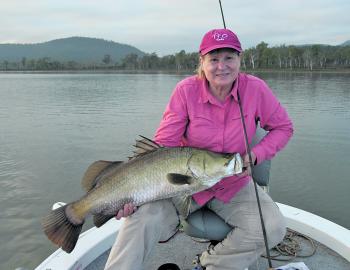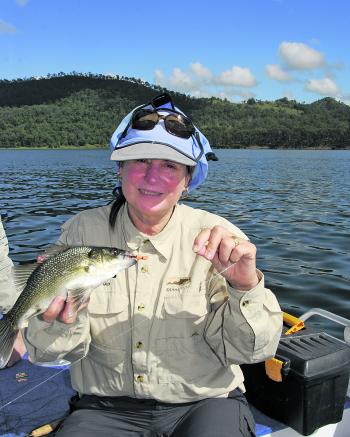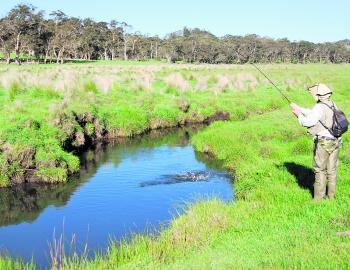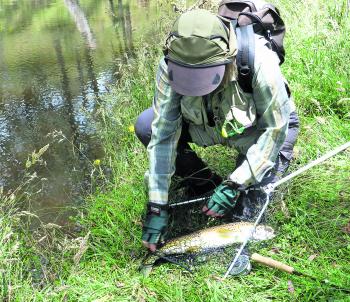In the freshwater there are fish that require finesse, some that require brawn, and others that demand both mastery of technique in casting and fly presentation. Last but not least there’s an iconic fish that is easiest to catch if you are prepared to put in a bit of effort to reap the rewards. They’re all specialities of summer!
Across the spectrum we’ll be looking at finesse fly fishing for bass, brawny barra, tricky trout and good old Murray cod in the sweetwater. These are all fish of summer and they’re great sport for fly anglers who really have the best of both worlds at their disposal.
The first fish on our summer hit list has to be bass. Forget the sinking lines and counting the fly down, which was so good in winter; this is exciting dry fly work with prime fishing times being dawn, dusk or even after dark. Dams such as Lenthalls, Maroon, and the upper reaches of coastal rivers where lilies, timber and weed beds provide cover are ideal spots to take a bass on a dry fly.
It’s finesse fishing, so long casts plus accurate fly presentations will enhance results. Casting from some distance back if afoot, or using the electric motor or a paddle to get within range of the chosen cover, will keep the fish guessing as to what’s going on. Then, when a fly like a 1/0 Gartside Gurgler or Muddler Minnow lands gently beside said cover, the bass will quickly grab it. Once the fly lands it’s wise to move it ever so slightly (try just jiggling the rod tip) to attract a fish because nothing hitting the water glugs or chugs. Usually, fallen creatures just wriggle or squirm.
If I had to nominate a handy place within a couple of hours’ drive of Southeast Queensland to score a bass on a dry fly at first light, I’d nominate the southeastern corner of Maroon Dam, in the narrow gully and channel running out from the roadside culvert and pipes, or one of the adjacent weed beds at the mouth of the channel. A rod’s length tapered leader with a 2kg tippet ensures the fish won’t be too wary, but do be gentle with the lift when setting the hook.
For anglers living further north, the lily beds (which will hopefully come back) at Lenthalls Dam are great for bass on the dry fly as well. Take the 5wt dry fly outfit and enjoy the experience.
If you’re a keen fly angler who likes a bit of a workout with the long rod and want to catch the fish of a lifetime, you have to chase barra. Impoundment fishing is the name of this game, and unfortunately there’s a bit of a drive from Southern Queensland for best chance of success. Northern dams such as Teemburra, Kinchant and Peter Faust (Lake Proserpine) seem to be the most favoured at the moment, but it wouldn’t surprise me if Awoonga or Monduran suddenly start firing. The fish in both of these impoundments seem to have some lock jaw tendencies.
Barra readily take flies, and anglers who target them score good fish. However, you need patience and the right conditions.
Sturdy 10wt tackle – exactly the same as for mackerel and tuna – is fine. Flies need to be both big and bold in colour. I tie my own rough looking creations on 4/0-5/0 Gamakatsu SL12S hooks, and the idea is to make sure the fly can be noticed. You want plenty of bulk and plenty of flash. I don’t believe there is one good colour. Mixes of gold and black, red or pink and white, purple and red can all work.
The main issue is finding barra on the job. I mainly target water that’s less than 2m deep, at least 25°C and which is some distance from the nearest hard stuff to prevent break-offs. It’s wise to have a small section of 15kg line in the leader, just behind a 20kg fluorocarbon as an anti bite-off section the fly is attached to. This 15kg section is sacrificial, designed to break instead of the fly line if a fish gets into hard cover.
Calm, settled weather is great for impoundment barra, and the best times are the same as for bass: very early of a morning, last thing of an evening and into the dark. There can be a lot of casts between fish but the rewards are worth the effort.
Trout are still a great stand by for the fly angler and are readily found only five or six hours’ drive from Brisbane up on the New England plateau. They demand light fly tackle, and 4-5wt outfits set up with floating lines are ideal. You need to employ a subtle, gentle approach, working quietly upstream, ready to cast to a moving fish or a likely lie such as the top water of a pool or next to some cover where there’s a bit of depth.
Forget the double hauling and long back casts. Much of this fishing will be in overgrown streams or very narrow bits of water where accuracy takes precedence over all else.
While our native fish can be picky and selective about bite times, trout are far more forgiving. Even strong easterly weather, which usually shuts native fish right down, won’t deter trout from feeding just after daylight or as the evening approaches. This trait is one of the great attractions of these feisty little fish, which make their own minds up as to whether the fly that’s just landed nearby is worth eating, or should simply be ignored.
To increase the odds in your favour, land the fly very gently if you’re using a dry fly, so there’s as little disturbance from the fly and leader tippet as possible. A controlled drift, with slack line under control as the fly comes back downstream, should see the fish take it with a gentle sip. A quick but gentle lift of the rod should set the hook.
Good dry flies to attach to a 2kg tippet during summer are Royal Wulffs, Black Beetles, Red Tags, Black Spinners, Grass Hoppers and Elk Hair Caddis, all in size 14. Fly floatant should be applied to both the fly and last section of fly line plus the top half of the tapered leader.
When it comes to wet fly fishing, I like to use a green, black or brown Woolly Bugger, leech or weighted nymph (all in size 10). You should apply some mud to the 2kg tippet so the fly sinks quickly prior to a gentle retrieve back downstream. Keep all slack out of the mix so you can easily detect the take.
Nymph fishing is different. The fish will actually bulge the surface without their heads breaking it, and it’s often during an insect hatch. For whatever reason the trout ignore the surface insects and choose to eat the nymphs instead. A size 14 black or brown seal’s fur nymph or the same sized hare and copper nymph cast gently to a surface bulger and allowed to dead drift back downstream will usually be taken eagerly. You should wet the nymph and last bit of leader to sink the fly just under the surface film.
There are many New England streams stocked with trout, and a lot of the best of them are within an hour’s driving distance of the hatchery at Ebor. The Guy Fawkes River, right in town next to the pub, has trout in it. On the right afternoon the number of trout in this stream can be surprising. New England trout streams are all shown on the internet, where you can purchase a NSW fishing license as well.
A four-hour drive south from Brisbane will see you in Granite Belt cod country. Many of these streams harbour these iconic fish, and because they tend to run clear they are ideal for anglers hell-bent on taking a cod on the fly.
The Severn River around Ballandean is stocked with cod, as are the waterways in Sundown National Park. Mind you, some of the New England streams (particularly those running west) also harbour cod, with the Macintyre River near Inverell a stand-out example.
Cod are supreme predators, and their willingness to eat anything that comes their way makes them very susceptible to flies. I’ve seen a cod take a small turtle jumping off a log, and dressed one that contained a bird along with small fish and shrimp.
Because cod vary in size in most waters, an 8-9wt outfit with the choice of both sinking and floating fly lines is ideal. The idea is to set up the floating line towards evening or in the early morning and change to a sinking line later in the day. A tapered leader with a 10kg tippet is ideal as these fish have abrasive dental work and, trust me, size sure can vary in any stream.
The best wet flies are baitfish style ones such as Pink Things, Deceivers and big Clousers in size 4/0-5/0, so that the fish notice them easily. Dry flies such as 4/0 Gartside or Grabhams Gurglers are great for dry fly work.
A steady, slow, retrieve is best for cod. You can chug the dry fly a few times, let it sit for around 20 seconds, then create a small disturbance again. Strip striking is vital; lifting the rod will only result in a lost fish.
Finding cod involves working cover. These fish love a roof over their head so any fallen timber, overhanging branches, weed or reed beds, undercut banks or boulders are all good places to cast a fly.
Granite Belt and New England cod live in some gorgeous countryside, a treat to camp in at this time of year. The trick to catching them is to suss out areas that are obviously not flogged, so take along some comfortable walking shoes and be prepared to get a bit wet now and again.
It’s all part of a summer of fun with the fly rod.
Reads: 4486
Denise Kampe with a decent fly caught barra from Lake Proserpine. (“You can lift it! That fish is only 17kg!”)

Denise Kampe with a Grabham’s Gurgler caught Maroon Dam bass. While the Maroon fish are smallish they are certainly willing starters.

Trout streams around Ebor are usually small and often overgrown, so accuracy and gentle presentation are more important than double haul casts.

The author with a decent cod taken near the willow in the background on a Gartside Gurgler.

Barra like this one from Kinchant Dam are there for the fly angler this summer.

Which fly now? New England streams offer a lot of choices for fly anglers.

Trout like this neat brownie are common in New England streams.




